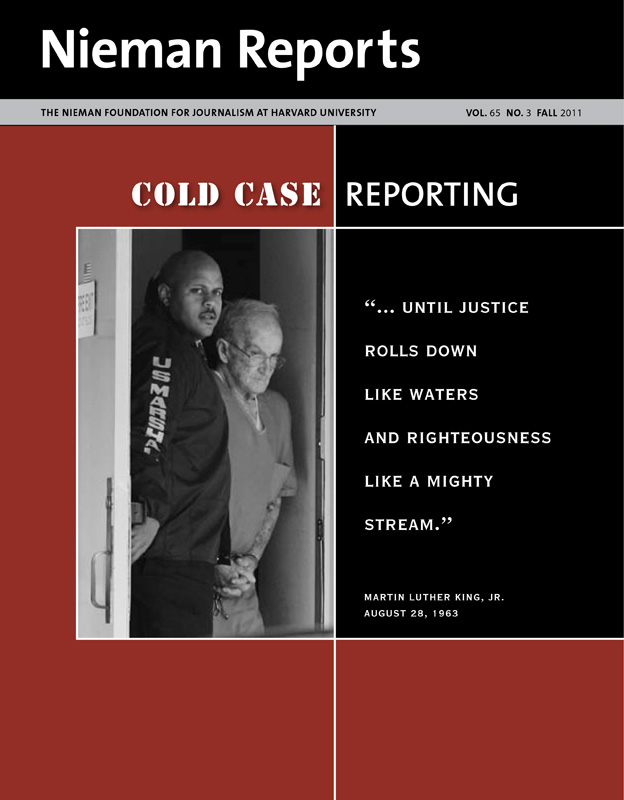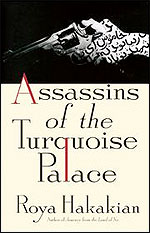"Injustice anywhere is a threat to justice everywhere," wrote Martin Luther King, Jr. in a letter from his Birmingham, Alabama jail cell in 1963. Back then, the jury was still out on the state of blacks in America and there were many who read King's words as little more than the self-serving plea of a plaintive prisoner. But triumph has a way of correcting faulty adjectives. By the end of the decade, "self-serving" had been edited to "noble" and "patriotic."
Such redefinitions usually follow great revelations. A story that was unknown or incompletely known is finally told in full or recast in an unprecedented way. It is as if a mirror is being held up in which the nation can see for the first time the incivility of its ways—the unsightliness of its segregated buses, for instance. These transformations are hailed as historic, but they are more. The human cost and drama that go into their making are the commentary, the fundamental narratives, which breathe life into the dead pages of history. Without knowing them, one could still score well on tests, but never grasp the dynamics of the living or shape sound policy. And they are often born out of Manichaean struggles, waged on streets or in courtrooms, which is how they are exposed and brought to the forefront of public consciousness.
I wrote about just such a narrative in a book called "Assassins of the Turquoise Palace," which was published in September. It tells the story of the political assassination of four Iranian opposition leaders at a restaurant in Berlin on September 17, 1992 and the investigation and lengthy trial that ensued. For more than a decade, the ruling clerics in Tehran had methodically persecuted Iranians in exile. In 1980, one year after his rise to power, Ayatollah Khomeini created a list of 500 of Iran's political and intellectual elite whom he considered "enemies of Islam." By the time the Berlin murders took place in 1992, at least 60 of those on the list had already been shot, stabbed or beheaded in Paris, Maryland, Manila, Bombay, Karachi, Istanbul, Vienna, Wembley, Larnaca, Geneva, Stockholm, Sulaymaniah, Tokyo, New Jersey, and Bonn.
These death sentences came before the word "fatwa" entered the Western lexicon and made Salman Rushdie a household name. Henchmen from around the globe were recruited to conduct these secret operations. In Berlin, Tehran's funds were poured into the city's main Shi'ite mosque where agents identified promising congregants and gave them jobs in innocuous grocery stores or other small businesses. These became fronts for their sinister operations. It would be several years until terror networks began to strike against Western targets. But the Ayatollah's fledgling cells, growing under Europe's oblivious skin, were already at work destroying the lives of expatriates, creating a blueprint for the next, more ambitious generation of killers.
The assassinations went on because European governments, for the most part, turned a blind eye to them. A few of the assassins were briefly detained but were quietly deported to Iran in the name of "national interest." Each time an assassin returned home safely, Tehran rewarded Europe by arranging for the release of their hostages held captive somewhere in the lawless corners of the world. Europe had adopted Tehran's math: dozens of dead Iranian exiles equaled one free European citizen.
When the judgment of guilty was rendered in a Berlin courtroom in April 1997, the perpetrators got what they deserved. But their masters, Iran's top leadership, too were implicated. European nations did that day what they had never done before or since: They recalled all of their ambassadors from Tehran and shut their embassies for several months. The consequences of their concerted action proved historic and enduring: For the first time, the West effectively put an end to the belligerence of Iran's regime without deploying a single soldier or the threat of bombs. Tehran's assassination campaign against the exiles came to a halt. And even more, the fledgling reform movement was injected with a shot of life. Less than two months after the end of the trial, presidential candidate Mohammad Khatami was elected, and a brief era of reform dawned.
Given the significance of these events—and with Iran being the most chronic foreign policy concern for the United States and Europe for nearly three decades—I was stunned to find that very few experts, even policymakers, knew about the case beyond headlines. Had this been a scientific breakthrough, not a political one, researchers would have pored over its every detail, moved the laboratory equivalents of heaven and earth, to find the cause of such a desirable effect. But politicians—and to my startle and dismay, editors and publishers—merely dismissed it as an anomalous bygone incident of Tehran behaving badly, yet again.
But this is, above all, the story of how the West, namely Europe, made Tehran's badness possible and even prolonged it, and also about how the journalists who covered the case, the survivors who refused to forget, and the persistence of a handful of lawyers, prosecutors and judges brought an end to that misbehavior. In every country, likely in every community, people carry secrets that when revealed can teach us much about who we are. In America's South, evidence of racial crimes hidden for decades is surfacing, and justice might still be served.
If injustice anywhere is the threat to justice everywhere, then all of us become prisoners, too, by our complicity or ignorance when the innocent languish in captivity, the guilty are not brought to justice, and the truth, our fundamental narrative, remains in the dark. To let light in, we—writers, journalists, and all other human Scheherazades—must go on doing what we do. We must go on telling.
Roya Hakakian is the author of two books of poetry in Persian and the memoir, "Journey from the Land of No: A Girlhood Caught in Revolutionary Iran." Her book, "Assassins of the Turquoise Palace," about Tehran's assassination campaign against exiled Iranians, was published in September (Grove/Atlantic).
Such redefinitions usually follow great revelations. A story that was unknown or incompletely known is finally told in full or recast in an unprecedented way. It is as if a mirror is being held up in which the nation can see for the first time the incivility of its ways—the unsightliness of its segregated buses, for instance. These transformations are hailed as historic, but they are more. The human cost and drama that go into their making are the commentary, the fundamental narratives, which breathe life into the dead pages of history. Without knowing them, one could still score well on tests, but never grasp the dynamics of the living or shape sound policy. And they are often born out of Manichaean struggles, waged on streets or in courtrooms, which is how they are exposed and brought to the forefront of public consciousness.
I wrote about just such a narrative in a book called "Assassins of the Turquoise Palace," which was published in September. It tells the story of the political assassination of four Iranian opposition leaders at a restaurant in Berlin on September 17, 1992 and the investigation and lengthy trial that ensued. For more than a decade, the ruling clerics in Tehran had methodically persecuted Iranians in exile. In 1980, one year after his rise to power, Ayatollah Khomeini created a list of 500 of Iran's political and intellectual elite whom he considered "enemies of Islam." By the time the Berlin murders took place in 1992, at least 60 of those on the list had already been shot, stabbed or beheaded in Paris, Maryland, Manila, Bombay, Karachi, Istanbul, Vienna, Wembley, Larnaca, Geneva, Stockholm, Sulaymaniah, Tokyo, New Jersey, and Bonn.
These death sentences came before the word "fatwa" entered the Western lexicon and made Salman Rushdie a household name. Henchmen from around the globe were recruited to conduct these secret operations. In Berlin, Tehran's funds were poured into the city's main Shi'ite mosque where agents identified promising congregants and gave them jobs in innocuous grocery stores or other small businesses. These became fronts for their sinister operations. It would be several years until terror networks began to strike against Western targets. But the Ayatollah's fledgling cells, growing under Europe's oblivious skin, were already at work destroying the lives of expatriates, creating a blueprint for the next, more ambitious generation of killers.
 |
| The high security inside a Berlin courthouse extended to the streets outside during a trial that exposed the unquestioned reach of Iran’s lawlessness. Photo by Hans Edinger/The Associated Press. |
The assassinations went on because European governments, for the most part, turned a blind eye to them. A few of the assassins were briefly detained but were quietly deported to Iran in the name of "national interest." Each time an assassin returned home safely, Tehran rewarded Europe by arranging for the release of their hostages held captive somewhere in the lawless corners of the world. Europe had adopted Tehran's math: dozens of dead Iranian exiles equaled one free European citizen.
When the judgment of guilty was rendered in a Berlin courtroom in April 1997, the perpetrators got what they deserved. But their masters, Iran's top leadership, too were implicated. European nations did that day what they had never done before or since: They recalled all of their ambassadors from Tehran and shut their embassies for several months. The consequences of their concerted action proved historic and enduring: For the first time, the West effectively put an end to the belligerence of Iran's regime without deploying a single soldier or the threat of bombs. Tehran's assassination campaign against the exiles came to a halt. And even more, the fledgling reform movement was injected with a shot of life. Less than two months after the end of the trial, presidential candidate Mohammad Khatami was elected, and a brief era of reform dawned.
Given the significance of these events—and with Iran being the most chronic foreign policy concern for the United States and Europe for nearly three decades—I was stunned to find that very few experts, even policymakers, knew about the case beyond headlines. Had this been a scientific breakthrough, not a political one, researchers would have pored over its every detail, moved the laboratory equivalents of heaven and earth, to find the cause of such a desirable effect. But politicians—and to my startle and dismay, editors and publishers—merely dismissed it as an anomalous bygone incident of Tehran behaving badly, yet again.
But this is, above all, the story of how the West, namely Europe, made Tehran's badness possible and even prolonged it, and also about how the journalists who covered the case, the survivors who refused to forget, and the persistence of a handful of lawyers, prosecutors and judges brought an end to that misbehavior. In every country, likely in every community, people carry secrets that when revealed can teach us much about who we are. In America's South, evidence of racial crimes hidden for decades is surfacing, and justice might still be served.
If injustice anywhere is the threat to justice everywhere, then all of us become prisoners, too, by our complicity or ignorance when the innocent languish in captivity, the guilty are not brought to justice, and the truth, our fundamental narrative, remains in the dark. To let light in, we—writers, journalists, and all other human Scheherazades—must go on doing what we do. We must go on telling.
Roya Hakakian is the author of two books of poetry in Persian and the memoir, "Journey from the Land of No: A Girlhood Caught in Revolutionary Iran." Her book, "Assassins of the Turquoise Palace," about Tehran's assassination campaign against exiled Iranians, was published in September (Grove/Atlantic).




